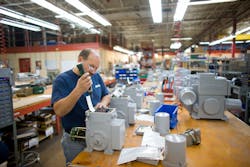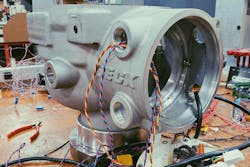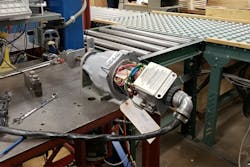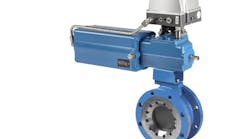Industrial process design and control are complicated affairs. There are many physical constraints and interacting variables that affect throughput, efficiency, product quality, operating safety and the environment. The control valve actuator is critical to all.
No matter your ultimate process objective, flow rates need to be controlled at various points throughout the process. Process variables, such as flow, temperature, pressure, tank levels and more, need to be tightly regulated to achieve the desired goals while maintaining operating safety and reliability. While it is the control valve that physically controls the process media, the actuator is the heart and brains of the operation — mechanically positioning the valve in response to the "instructions" from the plant’s process control system.
Far from being a drop-in commodity, actuators provide critically important process control. Indeed, selection of the right actuator makes a huge difference between process failure and success.
For example, consider the role of an actuator used to blend gasoline and ethanol before it is loaded on a truck for transport. The objective is to control an accurate ratio of ethanol to gasoline, but the different thermal expansion rates of gasoline and ethanol — as well as the need to isolate the blended mixture from water due to ethanol’s miscibility in water — pose challenges. For these reasons, the blending often is done in real-time while loading directly into the tanker trucks, and there is little room for variations in the ratio. Getting the needed control to avoid costly out-of-specification blends begins with accurate, consistent and reliable valve actuation.
Design considerations and needs assessment for specifying a valve actuator
Specifying an actuator requires attention to several details, all of which should be considered as early in the design process as possible. Design engineers should address the following questions during their needs assessment to help guide the specification process.
• Power availability and cost: How much energy will be devoted to running the actuator? Most plants want to run as efficiently as possible to save money and meet environmental sustainability goals. Not only do higher-voltage electric actuators consume more energy, but running three-phase lines can be costly. Running and supporting pneumatic infrastructure is even more costly. Some newer electric actuators can run on 12 volts, giving plants the ability to install them in remote areas and run them off of solar panels or fuel cells. Low power requirements also make backup power economical.
• Control objectives: How much tolerance does your process have for variation? The actuator’s precision and repeatability play key roles here. Will the actuator need to work intermittently or continuously? Actuators with duty-cycle limitations can overheat and trip out if they start and stop too often, and dead bands used to limit modulation can be too wide to provide fine enough resolution to achieve the required control. Actuators capable of continuous modulation, on the other hand, can respond to constant control requests and provide better resolution.
• Environmental safety conditions: Are explosive gases or dusts present? If yes, the actuator choice must carry appropriate Class and Division certifications.
• Environmental operating conditions: What is the expected ambient temperature range? Is the actuator outside in severe weather extremes or subject to submersion? Are the enclosure certification and rated temperature range of the actuator suitable for the production environment? Not all actuators can operate in all conditions.
• Type of valves: Does the process use rotary quarter-turn or linear control valves? Choosing the best valve type for an application is a science of its own, but once the choices are made for each application, the appropriate actuator style must be considered.
• Actuator sizing: What type of valves are used and how much force is required to actuate them? The actuator must be matched to both the type of valve and its required torque or thrust. An undersized actuator may not be able to operate the valve under all conditions, while an oversized actuator can potentially damage the valve stem. In some cases, as with butterfly valves that have high seating torque requirements compared to running torques, it may be appropriate to specify a linkage connection using a smaller, lower torque actuator instead of mounting a larger actuator directly to the valve stem. A linkage can be used to characterize the torque profile that the actuator applies to the valve. So, properly designed linkages make it possible to use a smaller actuator sized for the lower running torque required by the valve while producing much higher torques at the valve seat. The advantage is a more economical and space/weight efficient actuator. Regardless of the mounting approach, both oversizing and undersizing actuators can result in poor valve control.
What to look for in a control valve actuator
Once a needs assessment is completed, you will be in a better position to specify the right actuator to meet process requirements.
The actuator’s precision and ability to repeat ultra-fine movements are critical. In a sense, the actuator should almost be invisible to the process. Avoid an actuator with widely varying dead times or dead bands that limit the ability to make small and instant changes to valve position. Wide dead bands cause the actuator to wait until there are dramatic changes in the process before reacting and repositioning the valve. Instead, look for an actuator that reaches its full speed and torque within milliseconds and that stops in milliseconds, thus providing quick, reliable and precise valve operation. Also investigate the actuator’s reliability track record: If it tends to stop working every few months, there could be significant delays in production.
When evaluating actuator options, engineers need to be aware of the limitations of pneumatic, hydraulic and conventional electric actuator designs. For example, pneumatic actuators are susceptible to stick/slip response, excessive dead time, inconsistent performance with changing conditions and performance degradation over time. They also require costly and unreliable air systems, which can freeze or become contaminated.
Hydraulic actuators can provide good control performance because, unlike the air that powers pneumatic actuators, hydraulic fluid is incompressible, thus eliminating stick/slip and inconsistent response. However, they are more complex and can require costly maintenance. Hydraulic fluid leaks are another concern and can pose process and/or safety hazards. Leaks can subject processes like potable water or food processing to the risk of contamination. They also can pose a fire risk when used on combustion applications around furnaces or boilers.
Conventional electric actuators based on worm gear and induction motor designs eliminate the pneumatic and hydraulic shortcomings but have their own problems. They impose duty-cycle limitations to prevent overheating and motor damage, making them suitable for open-close or course control applications, but not where continuous good control is required. They also sacrifice valve positioning for the wider actuator dead bands needed to avoid modulation and not exceed the duty limitation of the motor. This problem, coupled with worm gear-induced backlash and motor coast, contribute to limit cycling, inconsistent and poor valve control, and high downtime and maintenance.
For the best combination of precision, repeatability and reliability, electric actuators designed for continuous, precise and modulating control are often a wise choice, and they are ideal for use in applications where process control performance is a concern. Continuous duty actuators should be capable of position changes in the range of 0.10 to 0.15 percent of full actuator travel consistently and under all conditions to avoid inconsistencies caused by poor positioning of the final control element.
“The most reliable electric actuators use a synchronous permanent magnet motor instead of an induction motor to avoid motor burnout.”
The most reliable electric actuators use a synchronous permanent magnet motor instead of an induction motor to avoid motor burnout. They also use high-efficiency spur gearing to allow for accurate, repeatable positioning of the actuator output and ultimately the valve. These actuators operate with a low power draw, which can drastically reduce operating costs while providing a wider variety of cost-effective power choices. The low draw also reduces power outage concerns because it is simpler to provide backup power for fail-to-position response or to maintain normal operation in the event of a power outage. Less gear wear prevents performance degradation, improves reliability and greatly reduces maintenance requirements.
Advanced versions of the continuous duty modulating actuator design that incorporate variable speed capabilities, even higher efficiencies and the ability to run on DC voltages down to 12 VDC, are now on the market. These new designs further increase flexibility, efficiency, performance and application suitability while maintaining the high reliability and low maintenance advantages.
“The right valve actuator can provide responsive, tight and stable process control over time with little or no maintenance required.”
When selecting an actuator supplier, also look beyond product performance to the supplier’s capabilities. Do they have in-house engineers who will work with you at every step of the process from initial design to installation and post-installation support? Are they available after hours for support? Do they design and manufacture centrally so they have full control over delivery dates and emergency requests? Do they fully test the performance of every actuator, or do they only do spot checks? Can they support legacy products and for how many years? How long is their product warranty and does that warranty extend to an unlimited number of starts/stops?
Conclusion
Actuators have a significant affect on process quality, productivity, safety, energy consumption, equipment life and the environment. The right actuator can provide responsive, tight and stable process control over time with little or no maintenance required. They should respond to a modulating controller demand signal instantaneously, regardless of changing loads and conditions, and continuously without duty limitations. They should not be subject stick/slip response, overshoot resulting from factors like motor coast or other performance inconsistencies.
For these reasons, process engineers need to carefully consider their actuator choices. Where process control performance is a factor, a continuous duty electric actuator is capable of precise, consistent control over time and under changing process conditions. They should also consider the actuator manufacturer and supplier, because support matters — today, tomorrow and years from now. Be sure to focus on the performance of the product, its history and the features that matter to your control objectives. All actuators are not created equally.
Scott Kempf is the marketing and application engineering manager at Harold Beck and Sons Inc., manufacturer of Beck actuators. He holds a B.S. in mechanical engineering from Drexel University and an MBA from Villanova University. Kempf has 37 years of experience in automation and industrial process control. He spent the first 10 years of his career at Moore Products Company, now a part of Siemens Industrial Automation, designing combustion control systems for industrial boilers and furnaces in a variety of industries. He came to Harold Beck and Sons to serve as the company’s process control expert, providing guidance for both product and market development. In his current position, he continues to provide product marketing and customer support.




